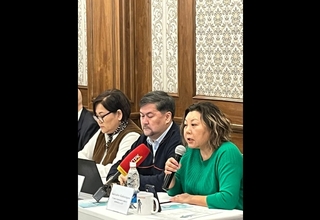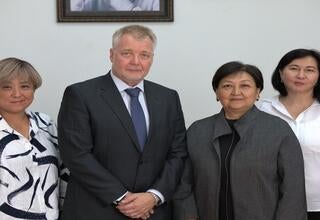
Ak Keme Hotel, Bishkek – Today, November 21, 2014 at 9:00 am
Kyrgyz Ministry of Health and the UNFPA run Round Table on reproductive health related issues.
Purpose of this interactive Round Table is approaching of public attention to reproductive health (RH) related issues. Many RH problems are beyond the health sector concerns and need intersectoral approach in addressing these problems. Key indicators of RH are used to fertility rate, neonatal and maternal mortality rates, abortions and frequency of use of various contraceptives by reproductive age population.
Within framework of “Den Sooluk” National Health Sector Reforming Programme to 2012-2016 implementation it is expected to present on this meeting the analysis of the National Strategy for Reproductive Health Protection in the Kyrgyz Republic to 2015 implementation and discuss next steps to further improvement of Kyrgyz population RH to 2020. It needs to build up wide and effective partner links between state authorities, NGOs, private sector, and international community for further development, implementation, and assessment of efficiency of RH protection programmes.
The Round Table will present findings and recommendations of the first national report on Confidential Enquiries into Maternal Death (CEMD). The purpose of CEMD is reduction of maternal mortality rate in the Kyrgyz Republic through revealing of actual reasons both medical and non-medical nature that lead to maternal death including social and family reasons too. It is expected to present the recommendations elaborated to improve quality of services delivered to pregnant women and women in childbirth in the Kyrgyz Republic (KR) which require intersectoral approach. Out of 149 maternal death cases officially registered in the KR from 2011 to 2012, 95 cases (64%) of birth records have been analyzed by the maternal death cases confidential audit methodology, out of those core reasons of women death during pregnancy, childbirth and postpartum were hemorrhage (43.2%), high blood pressure (19%), infection driven complications (13.7%). The analysis has allowed segregating medical assistance delivery problems where along with health sector related reasons there were socio-economic vulnerability of a mother; internal and external population migration; unawareness of a woman and her family members on dangerous signs of pregnancy and postpartum period; and late appeal to medical assistance.
A proportion of maternal death cases against total death rate among women aged 15 to 49 has dropped from 5.5 to 3.3 % from to 2010 respectively.[1]Also there is a tendency[2] observed within recent years on decline in maternal mortality rate (75.3 every 100,000 live births in 2009, 50.3 every 100,000 live births in 2012, 39.2 every 100,000 live births in 2013). However great efforts are still needed to achieve goal defined.
In order to estimate access of low income and socially vulnerable population groups to quality contraceptives related services, current family planning related situation in the Kyrgyz Republic has been analyzed. Lack of a mechanism to secure the medical-social risk group with family planning services is one of factors affecting women health indicators.
Recognizing a vital need in satisfaction of existing family planning related needs some additional resources and political commitments to be taken by the Government on implementation of the family planning programmes are required.
[1] Source: World population prospects: the 2010 revision. New York, Population Division, Department of Economic and Social Affairs, United Nations Secretariat, 2011.[1])




